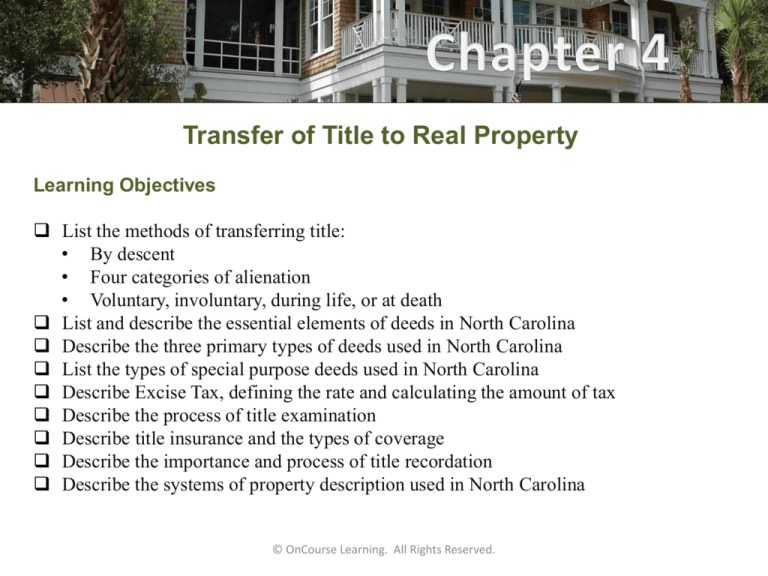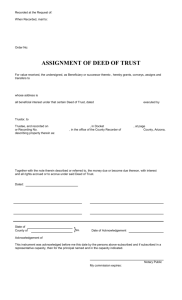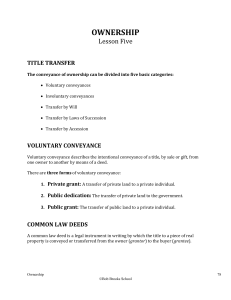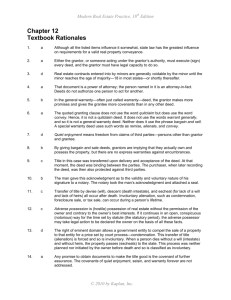
Transfer of Title to Real Property
Learning Objectives
List the methods of transferring title:
• By descent
• Four categories of alienation
• Voluntary, involuntary, during life, or at death
List and describe the essential elements of deeds in North Carolina
Describe the three primary types of deeds used in North Carolina
List the types of special purpose deeds used in North Carolina
Describe Excise Tax, defining the rate and calculating the amount of tax
Describe the process of title examination
Describe title insurance and the types of coverage
Describe the importance and process of title recordation
Describe the systems of property description used in North Carolina
© OnCourse Learning. All Rights Reserved.
Transfer of Title to Real Property
Property Description
Adequacy of Description:
• Real property must be described in a legally and professionally acceptable
manner
• Ambiguity in a real property description will likely result in a cloud on the
title to the property
Methods of describing real property:
• Metes and Bounds –Method most often used in North Carolina:
• Based on distances and direction
• Metes - distance from point to point in the description
• Bounds - direction from one point to another in the description
• Government Rectangular Survey – Not used in North Carolina:
• Divides the country into ranges (6 square miles) using:
• North-south lines called principal meridians, and
• East-west lines called base lines
© OnCourse Learning. All Rights Reserved.
Transfer of Title to Real Property
Property Description
Methods of describing real property:
• Government Rectangular Survey – not used in North Carolina:
• Divides ranges into townships (1 mile square)
• Divides townships into sections (640 acres) which may be further
subdivided
• Description by Reference:
• Reference to recorded plat (lot and block):
• Refers to the plat which determines the exact location and
dimensions of the real property from the metes and bounds
• Often used for real property within subdivisions
• Informal Reference:
• Typically a street address
• Never to be used in a deed or deed of trust
© OnCourse Learning. All Rights Reserved.
Transfer of Title to Real Property
Property Description
© OnCourse Learning. All Rights Reserved.
Transfer of Title to Real Property
Example #1: How many acres
are in the NE ¼ of the SW ¼
of the NW ¼ of a given
section?
© OnCourse Learning. All Rights Reserved.
Transfer of Title to Real Property
Property Description
Property Survey:
• Determination of location and boundaries of a specific tract of land
with location of buildings, fences, any other structures, and
locations of easements and rights-of-way
• Surveys should be performed by a licensed surveyor or engineer
• Surveys will typically disclose existence of any encroachments
A metes and bounds descriptions can only be made from a
survey performed by a licensed, registered land surveyor
© OnCourse Learning. All Rights Reserved.
Transfer of Title to Real Property
© OnCourse Learning. All Rights Reserved.
Transfer of Title to Real Property
Property Description
Point of Beginning (POB):
• The point of beginning and ending in a metes and bounds
description
Real property description:
• May contain a statement as to the number of acres or quantity
of land being conveyed
• Number of acres or quantity must yield to the description of
land as defined in the metes and bounds
© OnCourse Learning. All Rights Reserved.
Transfer of Title to Real Property
© OnCourse Learning. All Rights Reserved.
Transfer of Title to Real Property
Methods of Transferring Title
By Descent (Intestate Succession)
By Will
By Deed (Voluntary Alienation)
By Involuntary Alienation
• Lien Foreclosure Sale
• Adverse Possession
• Escheat
• Condemnation under Eminent Domain
© OnCourse Learning. All Rights Reserved.
Transfer of Title to Real Property
Essential Elements of a Valid Deed
Must be in writing according to the Statute of Frauds
Grantor – Conveys the deed
Grantee – Receives the deed
Property Description:
• Important that the description distinguishes the subject property from all
other properties
Words of Conveyance:
• Words demonstrating the grantor’s intention to transfer the title to the
named grantee
Execution:
• Each grantor must sign conveying his/her interest to the grantee
• The grantee is not required to sign but must be identifiable
Delivery and Acceptance:
• The valid and executed deed must be delivered by the grantor to the
grantee
• Grantee must accept the deed voluntarily
© OnCourse Learning. All Rights Reserved.
Transfer of Title to Real Property
Non-Essential Elements of a Valid Deed
Acknowledgment (Notarized):
• Does not have to be acknowledged or recorded to be valid and enforceable
• Acknowledgement is necessary before the deed can be recorded, but not
for the validity of the deed
Consideration:
• The deed does not need to recite the specific consideration given
Seal:
• Deeds do not have to be sealed in North Carolina to be valid
Recording:
• Gives constructive notice of grantee’s title to all the world
• Provides protection to the grantee from everyone, including subsequent
purchasers of the same property from the same grantor
© OnCourse Learning. All Rights Reserved.
Transfer of Title to Real Property
Non-Essential Elements of a Valid Deed
Witnessed:
• In North Carolina, it is not necessary for the grantor’s signature
(execution) to be witnessed
Date:
• Deeds do not have to contain the date to be valid
• The acknowledgement, if any, will provide the date
• A gift deed must be recorded within two years to remain valid
• A date is needed to establish the time of the gift in order to avoid
confusion about the two year period
© OnCourse Learning. All Rights Reserved.
Transfer of Title to Real Property
Types of Deeds
General Warranty Deed:
• Provides most liability for the Grantor
• Least risk for the Grantee
• Covers all claims, even though preceding the Grantor’s ownership of
property
• There are six covenants of a General Warranty Deed:
1. Seisin (Seizin)
2. Right to Convey
3. Against Encumbrances
4. Quiet Enjoyment
5. Warranty
6. Grantees Rights to Recovery
© OnCourse Learning. All Rights Reserved.
Transfer of Title to Real Property
Types of Deeds
Special Warranty Deed:
• Warrants against claims arising during the grantor’s period of ownership
• Does NOT warrant claims arising prior to grantor’s ownership
Quitclaim Deed (Non-Warranty):
• Used when no warranty is expected or necessary
• Often used to clear a cloud on a title
• Provides least liability for grantor and most risk for grantee
• Typically used for a Special Purpose Deed:
• Deed of Correction (Confirmation)
• Deed of Release
• Deed of Surrender
• Deed of Gift
• Judicial Deed
© OnCourse Learning. All Rights Reserved.
Transfer of Title to Real Property
Excise Tax
Excise Tax (Revenue or Transfer Stamps):
• Amount based on consideration received by the seller in the
sale of the real property by deed
• Excise tax is $1 for every $500 (or portion thereof) of the
full purchase price
• Typically paid for by the seller at closing
© OnCourse Learning. All Rights Reserved.
Transfer of Title to Real Property
Title Assurance
Covenants of Title in Deeds:
• General Warranty Deed covenants – most assurance
• Special Warranty Deed covenants – less assurance
• Quitclaim Deed covenants – no assurance
Title Examination Procedures:
• Title Examination – used to determine the owner and quality of title.
Limited to recorded documents on public record
• Chain of Title – list of owners during the statutory time period
• Attorney’s Opinion of Title – opinion of who is the legal owner and the
quality of their title
© OnCourse Learning. All Rights Reserved.
Transfer of Title to Real Property
Title Assurance
Title Insurance – coverage that protects the purchaser or mortgagee from
losses due to title defects
• Owner’s Policy:
• Written for the protection of the owner
• Coverage in the amount that the owner paid for the property
• Policy remains in effect for the duration of the insured’s ownership
of the property
• Continues in effect after the owner conveys the property to protect
policy holder from claims of subsequent grantee
• Claims arising during policy holder’s ownership are not covered
during his ownership or against claims of subsequent grantee
© OnCourse Learning. All Rights Reserved.
Transfer of Title to Real Property
Title Assurance
Title Insurance:
• Mortgagee’s Policy:
• Mortgagee is insured against defects in the title pledged
as security in the mortgage
• Coverage is limited to the outstanding balance of the
mortgage
• Leasehold Policy:
• Written to protect a lessee (leaseholder) and/or a
mortgagee against defects in the lessor’s title
• The policy is issued to a mortgagee if the mortgagor has
pledged a leasehold interest instead of a fee simple title
as security for the mortgage debt
© OnCourse Learning. All Rights Reserved.
Transfer of Title to Real Property
Title Assurance
Title Recordation:
• Recordation is not required in North Carolina
• Recordation provides “constructive notice” to third parties
The Connor Act:
• Certain real estate documents are not valid against third parties until
recorded
• Documents are still valid between the grantor and grantee
• Makes North Carolina a “pure race” state
• Good rule of thumb is if a document has to be in writing according to the
Statute of Frauds it has to be records to protect that interest
© OnCourse Learning. All Rights Reserved.
Transfer of Title to Real Property
Title Assurance
Marketable Title Act:
• The Statute of Limitations for most title defects is 30 years
The Torrens System:
• Titles for real property are registered in a manner similar to motor vehicles
• A change in the status of the property requires that the old registration
certificate be destroyed and replaced with a new one
• Advantage – eliminates possibility of someone claiming title by adverse
possession
© OnCourse Learning. All Rights Reserved.





